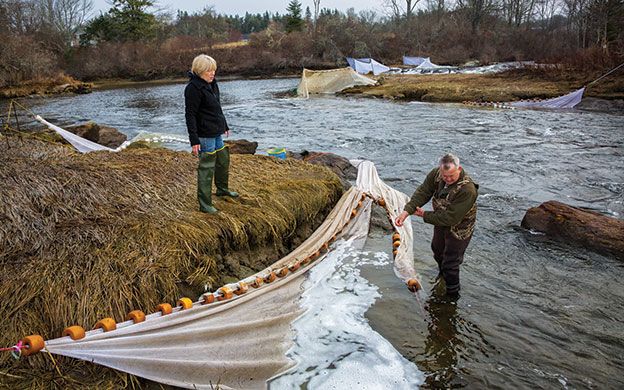A wild fishery tamed: Maine elvers are in demand in Asia, but quotas limit catch
Starting in late March, hundreds of fishermen leave the cozy warmth of their homes, prepared to spend the freezing night or dawn hours along coastal estuaries. Navigating slippery banks and rocks, wading in frigid water, enduring bad weather, staying awake through the tide cycle on three or four hours of sleep, they await the arrival of millions of tiny, translucent creatures called elvers that have traveled 1,200 miles from the Sargasso Sea.
Using dip nets or funnel-shaped “fyke” nets, each fisherman is authorized by the state to harvest a tiny quota of elvers (sometimes called “glass eels”) as they swim from saltwater to freshwater, throughout a season that lasts until the end of May.
The harvested elvers were originally destined for life on the East Coast, growing to adulthood as “yellow eels” and spending years in freshwater before migrating back as “silver eels” to the Sargasso to spawn and die. (Names reflect changes in pigmentation.) Instead, they're in for an unexpected detour. Treated with care to ensure they stay alive, Maine landings are shipped to aquaculture facilities in Asia, where they will be grown to adult size, then processed for an ever-increasing food market.
Maine is the heart of the East Coast elver fishery — one of only two states allowed to harvest the tiny creatures (the other is South Carolina, where only 10 licenses are issued and fishing locations are limited). Landings for Maine's elver fishery, constrained for the first time in 2014 by an overall state quota, declined by more than 8,000 pounds, from 18,076 pounds in 2013 to 9,690 pounds. Value also decreased by more than $24 million to a total of $8.47 million, attributed in part to the quota constraint and a decline in per pound value from 2013 of nearly $1,000. The decline in value for the elver fishery moved it from the second most valuable, a position it held for two years, to fourth.
Even so, enormous profits in recent years have made those cold, dark nights more than worthwhile. And some predict there are more opportunities to come, both in Asia and the United States.
Dramatic price spikes
“When I first got in, it was known as a 'secret society'” says Julie Keene, who lives in Trescott Township. Keene has been involved in the fishery since 1994 and is secretary of the Maine Elver Fishermen Association. “It was done in the dead of night, and it was a very small fishery where you had your spot, or a couple of spots. People didn't bother each other. Then the price went through the roof.”
A price boom in recent years had a Wild West-like start characterized by pickup truck dealings, cash transactions of tens of thousands of dollars and rampant poaching. Then, the industry organized and new regulations were implemented to sustain legitimate harvesting for continued export; stakeholders are now discussing how to leverage the value of elvers by creating domestic eel farming and processing operations.
Although yellow and silver eel fisheries have a long history in Maine, elver fishing is relatively recent.
It began in the early 1970s as a low-key, sporadic, but worthwhile operation for anywhere from a handful of fishermen to a couple of thousand, at times, attracted to earning as much as several hundred dollars per pound for the Asian market. With its short springtime season, the fishery is just one of several fisheries that contribute to the annual income of many fishermen. The fishery took a dramatic turn in recent years due to intensified demand from Asia stemming from declines in the European stocks that Asian eel farmers had been using.
With a small but experienced fishery already in place, Maine was poised to fill the gap.
“All of a sudden, the people who'd kept the market in Maine alive said, 'We can sell a lot of glass eels,” says Jeffrey Pierce, an industry advocate and a state legislator from Dresden who serves on the Marine Resources Committee. “With none coming from the European Union, all of a sudden buyers said, 'We can get this product in Maine.' And they paid dearly for it.”
The spike in prices was dramatic. In 2010, Maine's elvers were worth less than $200 per pound. In 2011, they averaged nearly $900 and reached more than $2,000.
By 2012, “everybody and his brother wanted to be an elver fisherman,” says Pierce. That year, elver prices reached $2,600 per pound and averaged $2,000. In 2013, fishermen earned $1,700 to $2,000 per pound. Landings jumped from a pre-boom 3,000 pounds in 2010 to 20,000 pounds in 2012. Overall value soared, from $584,000 in 2010 to $38 million in 2012. Landings and value dropped slightly in 2013 and then plummeted to 2014's $8.47 million catch due to the quota constraint and a decline in per pound value from 2013 of nearly $1,000.
Not surprisingly, harvester numbers shot up, from fewer than 300 in 2004 to 658 in 2013. In 2014, the total statewide quota was 11,749 pounds, but for 2015 it will be 9,688 pounds, which is the total harvested last year.
Despite the price and quota fluctuations, longtime Ellsworth fisherman Darrell Young says he and his wife did fine in 2014. Each had a 68-pound quota, and earned between $500 and $1,000 per pound.
About 20% of the quota was set aside for Maine's federally recognized Native American tribes, which have a parallel management system, co-administered with the state, in recognition of their historical fishing rights. Among tribal members of the Penobscot Nation, for example, 48 fishermen currently hold licenses, with about 100 on a waiting list.
“It's great that some of our tribal members are able to bring in some needed revenue, practicing an activity that is part of our culture,” says John Banks, the Penobscot Nation's director of natural resources. At the same time, he says, two bills now before the Legislature, which would allow Maine's Wabanaki tribes to administer their elver fishery more independently but within quota restrictions, address concerns about state intervention.
“The state seems to not want to cooperate with us in the management of glass eels,” Banks said. “History has shown the tribes are capable of being the stewards of these resources. It wasn't the tribes that caused the decline of the fishery and caused the collapse of the ecological conditions of our rivers. The tribes have always made sure they provided for spawning escapement. The original dams built by the colonists didn't allow for escapement, and they decimated the fish runs. It's ironic the state wants to control the tribes' access to these resources.”
Storm clouds on the horizon?
In the meantime, the Atlantic States Marine Fisheries Commission, an interstate management body, is thinking about the overall health of the eel stock. An assessment found the American eel population for all life stages depleted due to overfishing and other human impacts, especially dams, hydroelectric turbines and climate change. The U.S. Fish and Wildlife Service is considering a proposal to have the American eel listed as “threatened” under the Endangered Species Act; a decision is expected later this year.
The assessment prompted the Atlantic States Marine Fisheries Commission last October to impose a reduced quota for 2015-2017. At a recent Maine Elver Fishermen Association meeting, fishermen opposed the reduction. But they agreed they benefited from at least having stability for three years.
The Youngs, for example, took a big cut; they now have 60 pounds between them. This season started late due to frigid water, which deters juveniles. With prices starting out at a speculative $2,000, the delay is unfortunate, Young says. “I'll be surprised if we catch our quota,” he says. “Most of the eels will run in June.”
Some fishermen and dealers say the proposed Endangered Species Act listing is unwarranted. Calling the proposed listing “ludicrous,” fisherman and dealer/exporter Patricia Bryant of Nobleboro, who has been in the elver business since the 1970s, adds, “This species has been around for billions of years. How are you going to possibly overfish something that has survived everything from the Ice Age on?”
Mitchell Feigenbaum, who runs the Delaware Valley Fish Co. in Portland, the largest exporter of Maine's elvers, considers the quota reductions unavoidable, given federal concerns about eel populations. But “recruitment has been positive and there has been improved fishery management, dam removals and habitat protection established over the past decade,” he says, adding he's “cautiously optimistic” the U.S. Fish and Wildlife Service won't list the American eel as a threatened species.
Feigenbaum, who estimates Maine exports currently represent 10% to 35% of baby eels shipped live to Asia then farmed there, predicts that demand will continue to increase among China's growing middle class. He said there is presently little support among East Coast states for growth of the fishery. However, the Atlantic States Marine Fisheries Commission's regulations create room for limited expansion, with provisions allowing Maine to petition for a future increase in its glass eel quota based on conservation improvements. The regulations also spell out conditions under which other states can request limited participation.
At the same time, there's movement in Maine to establish an eel farming industry for overseas and domestic sales.
At the University of New England in Biddeford, Barry Costa-Pierce is director of the Marine Science Program and a member of the regional Eel Aquaculture Team, a coalition of researchers, fishermen, European advisors and potential partners in Nova Scotia. He says the prospects for Maine eel farms are excellent. Plans are in the works at UNE and the University of Maine to test farming technologies. Next steps involve obtaining seed money, acquiring equipment, adapting techniques to Maine's climate, and forging market connections, initially in the Northeast and potentially throughout the world as product quality and the technology for shipping live eels improve.
“We have the seed stock, the knowledge, the land, water, and labor, and the feeds are available,” Costa-Pierce says. “The market is there, that's for sure.”
Domestically, over 200 tons of eels are imported from Japan and Korea to the Northeast for food consumption. “This is one of the world's most absurd foods,” he says of the region's consumption of imported eels. “We export everything we could grow here and we import everything we eat here.”
Read more
Eels won’t be listed under Endangered Species Act













Comments